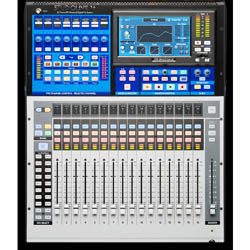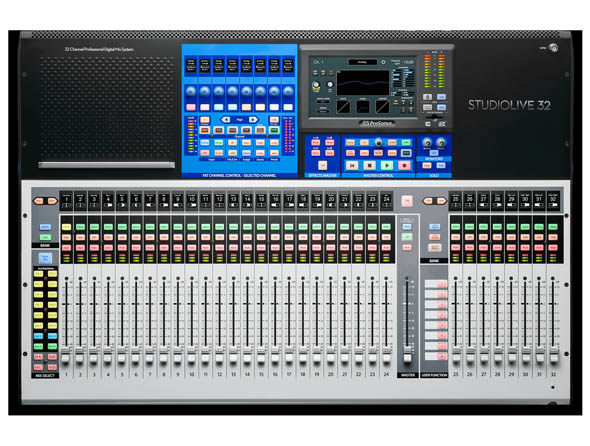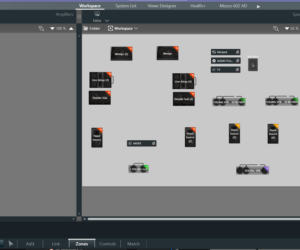The third generation of PreSonus StudioLive Series III digital console/recorders launches with two models: the 16-channel StudioLive 16 with 17 touch-sensitive, motorized faders, 17 recallable XMAX preamps, and 24 inputs; and the StudioLive 32 with 33 touch-sensitive, motorized faders, 33 recallable XMAX preamps, and 40 inputs. They’re both at the NAMM show this week in Anaheim at Booth 5700, Hall A.
PreSonus Capture multitrack recording software with virtual sound check is installed directly into StudioLive Series III consoles. With just one touch, Capture records up to 34 tracks to the console’s onboard SD recorder. When finished recording, open the Capture session in Studio One for Mac and Windows (included), and the entire mix scene will transfer to a Studio One session, including fader levels and Fat Channel settings.
The Fat Channel processing section has received a major overhaul, including a plug-in-style workflow that includes vintage-style EQ and compression options on every channel, including classic tube limiters and passive EQs. In addition to channel processing, StudioLive Series III consoles offer 6-band, fully parametric EQ on all mix outputs.
Layers for the channel faders let users place any channel or bus fader anywhere they want. The Fat Channel layout can also be customized.
Further, with Scene Safe, a scene change won’t alter the settings on designated “safe” channels. Similarly, Fat Channel presets have, for practical purposes, become like scenes for individual channels, not only saving input and Fat Channel settings but also aux send and bus assignments. Users can also utilize preset filters to choose what they want to recall.
Sixteen (16) FlexMixes can be individually designated as aux, subgroup, or matrix mixes. This is in addition to the four fixed subgroups, for a total of 20 mix buses, not counting the main mix, effects mixes, and solo buses. And with 24 DCAs, users can more easily and flexibly control groups of channels. Further, there’s a choice between 1-to-1 or split-layer workflows: Assign all channels to the top layer, with one fader per input channel, or split the faders between inputs and outputs, including DCAs and aux outputs.
An AVB Ethernet connection enables networking compatible computers and streaming up to 55 channels of audio to and from a Mac or Windows PC. (AVB networked solutions, including stageboxes, personal monitor mixers, and increased third-party AVB interoperability, are coming later in 2017.) There’s also 38 x 38 recording via USB 2.0. In addition to the AVB recording connection, StudioLive 32 consoles sport a 1 Gb Ethernet port that can connect to a wireless router or directly to a computer, providing remote control of virtually all features via a wired or wireless connection.
Mix wirelessly or over a wired network from anywhere using free UC Surface touch-control software for Mac, Windows, and iPad. Even add a second, third or fourth screen for faster workflow. Remote control the mixer’s recallable XMAX preamps and Fat Channel processing with Studio One (included) for low-latency recording with effects. Completely automate virtual sound checks and record shows with Capture for Mac and Windows (included)—or record with Studio One or with any software that supports ASIO or Core Audio.
The StudioLive 16 comes with Studio One Artist, while StudioLive 32 is supplied with Studio One Professional. Monitor mixes can be controlled onstage with free QMix-UC for iPhone, iPod touch, or Android device without the need for large monitor networks.
StudioLive 32 digital console/recorders are available immediately with a U.S. MAP price of $2,999.95; StudioLive 16 will ship later in Q1 of 2017 at an anticipated MAP price of $1,999.95.
















